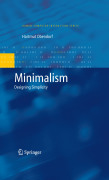
The notion of Minimalism is proposed as a theoretical tool supporting a more differentiated understanding of reduction and thus forms a standpoint that allows definition of aspects of simplicity. Possible uses of the notion of minimalism in the field of human–computer interaction design are examined both from a theoretical and empirical viewpoint, giving a range of results. Minimalism defines a radical and potentially useful perspective for design analysis. The empirical examples show that it has also proven to be a useful tool for generating and modifying concrete design techniques. Divided into four parts this book traces the development of minimalism, defines the four types of minimalism in interaction design, looks at how to apply it and finishes with some conclusions. Features a constructive theoretical framework: Simplicity - an often-cited design value is analysed using the notion of minimalism Transdisciplinary approach to design of interactive systems INDICE: Preface.- Part 1 Designing for an Age of Complexity.- Minimalism Introduction and Synopsis.- Part II Defining Minimalism.- In Search of Minimalism – Roving in Art, Music and Elsewhere.- Minimalism for Interaction Design: aProposal.- Part III Rethinking Minimalism.- Minimalism Industrial Design and HCI.- Minimalism, Simplicity and Rules of Design.- Part IV Applying Minimalism.- Detecting the Minimal.- Designing the Minimal.- Part V Reflections on Minimalism.- Minimalism Revisited.- Bibliography.- Index.
- ISBN: 978-1-84882-370-9
- Editorial: Springer
- Encuadernacion: Cartoné
- Páginas: 305
- Fecha Publicación: 01/06/2009
- Nº Volúmenes: 1
- Idioma: Inglés
